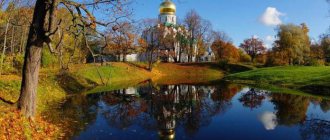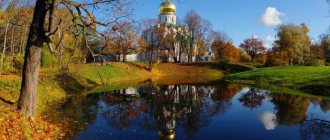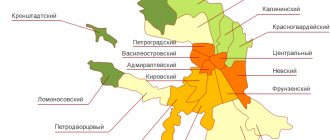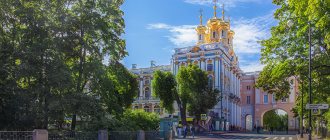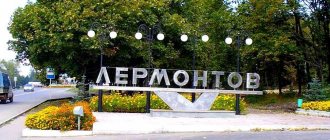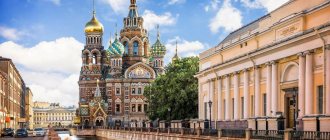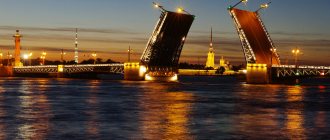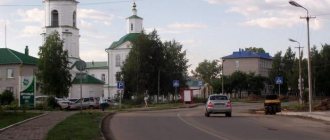> Countries Russia St. Petersburg
Pushkin is one of the most picturesque suburbs of St. Petersburg. Historical and architectural monuments of the 18th century and residential buildings of the 19th century are well preserved here. It includes the famous Tsarskoe Selo museum-reserve with picturesque parks, luxurious palaces and unusual pavilions. This is a great travel destination where you can see the center in one day, as well as admire nature or immerse yourself in the rich history of these places.
- In the center
- Neighborhood
- Excursions
- Map
The significance of the city of Pushkin in the modern world
The city of Pushkin is part of the district of the federal city of the same name called St. Petersburg and its intracity municipal formation.
Over the years, the settlement was called:
| Before 1710 | Sarskaya Manor |
| Before 1724 | Blagoveshchenskoe |
| Before 1780 | Sarskoe village |
| Before 1917 | Tsarskoye Selo |
| Before 1918 | Soldiers' Village |
| Before 1937 | Children's village named after Uritsky |
Currently, a public movement has been founded in the city, which advocates the return of the historical name “Tsarskoye Selo”.
The city is the largest tourist, scientific, educational and military-industrial center. The date of its foundation is 1710. The settlement received city status in 1808. Its total occupied area is 89,241 square meters. km.
Initially, the city was positioned as a country imperial residence. Subsequently, a museum was organized here. The iconic monument of urban planning art and the palace park complex (founded in the 18th-20th centuries) is called “Tsarskoe Selo”. It included the world famous Catherine Park, Catherine Palace and numerous other religious buildings.
The modern layout of the city was determined at the beginning of the 20th century. Pushkin has a clear layout and consists of 2 main parts: northeastern and southern.
The northeastern part of the settlement arose on the site of the Old Sloboda and has the main Cathedral Square on its territory. Almost all the streets of the district intersect at an angle of 90°; the oldest streets are called Sadovaya, Srednyaya and Malaya.
The southern part of the city is located on the site of the former city called Sofia and its center is Sofia Square.
The modern administrative division of the city into districts:
- Historical Center;
- Sofia;
- Krasnoselka;
- Friedenthal Colony;
- BAM;
- New village;
- Belozerka;
- Novoselki;
- Pavlovsk;
- Lesnoye;
- Kondakopshino;
- Novokondakopshino;
- Volkhonka.
General information about the area
Pushkinsky district is one of the most aristocratic and tourist areas of St. Petersburg. There are several imperial residences here, which are now architectural monuments and UNESCO World Heritage Sites. At its core, the area was and is today a suburb of St. Petersburg, included within the city limits.
Catherine Palace
Pavlovsk Palace
Clean air, good ecology, stunning beauty of palace and park ensembles and elite small apartment real estate on the one hand, broken roads, inconvenient transport links and standard problems of the city outskirts on the other hand - perhaps this is the contradiction of this amazing area, which we will try to tell you about more details.
Today, Pushkinsky district is a union of several disparate municipalities. It includes the city of Pushkin, the city of Pavlovsk, the villages of Shushary, Aleksandrovskaya and Tyarlevo, as well as several smaller settlements. Its total territory is about 236 square kilometers, and, according to the 2010 census, 136 thousand people live here, the vast majority of whom are registered in the city of Pushkin. The number of people wishing to move to the Pushkinsky district is increasing from year to year.
The city authorities and the St. Petersburg metro plan to open the Shushary metro station here by 2017. This event is eagerly awaited by both residents of the area and numerous developers of residential complexes, for whom the main problem in selling real estate in the Pushkinsky district is precisely its inconvenient transport links with the city. Despite the fact that several major highways and federal highways pass nearby - Pulkovskoye and Moskovskoye highways, Vitebsky Prospekt, Rossiya, Pskov and Narva highways, the Pushkinsky district constantly experiences transport difficulties. Motorists are regularly stuck in traffic jams, and public transport (suburban trains, buses and minibuses) has long ceased to cope with the influx of people wanting to travel to St. Petersburg and back to work and study.
Traffic jam at the entrance to Pushkin
As mentioned above, a lot of housing is being built. There are offers in economy class, as well as comfort and business class homes. On the vast territory of the district, townhouses, cottage communities and other comfortable small-apartment housing are being actively built, concentrating modern infrastructure facilities around them and, without a doubt, attractive to those who choose to combine almost country life with proximity to the metropolis.
Townhouses
Residential complex in Shushary
The area is too heterogeneous: Pavlovsk, Pushkin and other municipal divisions differ from each other in appearance, infrastructure, and other characteristic features, even down to the history of their appearance. Therefore, we will talk in more detail about each of them in the section devoted to the municipal districts of the region. The common features that make up the image of the Pushkinsky district are also the abundance of parks and green spaces. Some of them are part of tourist attractions, others are simply picturesque walking areas, where residents of all districts of St. Petersburg come with pleasure to relax and unwind from the bustle of the city.
A park
A park
The Pushkinsky district is convenient due to the lack of long-distance telephone communication, one of the problems of the nearest suburbs of St. Petersburg, territorially belonging to the Leningrad region, relatively low prices for housing and communal services (the average bill is 1000-1300 rubles) and a well-developed infrastructure for a remote area: there are schools, and kindergartens, and hospitals, and the opportunity to have fun and make the necessary purchases. Again, if you have a car, then there are transport interchanges nearby to the Ring Road, from where you can get to large hypermarkets, shopping malls and just into the city.
Highway to Pushkin
There is little industry in the area, there is a lot of greenery, it would seem that this is one of the best options for living in St. Petersburg, however, the above-mentioned problems with transport, isolation from St. Petersburg and, as a result, the aggravation of all communal and criminal problems, a huge social gap are still those difficulties that significantly hamper the development of the area and make it less attractive for both investors and potential residents.
In Pushkin, for example, most of the houses are not represented by elite new buildings, but by boring blocks built and inhabited in the last century, with undeveloped courtyards and shabby facades. The population is very diverse: the “indigenous” residents are gradually remaining in the minority, and in many ways, the Pushkinsky district, if you exclude the sights, is no different from other outskirts of St. Petersburg.
Houses in Pushkin
Climate
The city of Pushkin is located in a humid and temperate climate zone, which is gradually transforming from marine to continental.
Over the years of meteorological observations, the following climatic conditions have been recorded in the city:
| Month | Day °C | Night °C | Comfort rating out of 5 |
| January | -5,3 | -9,4 | 2,5 |
| February | -3,6 | -8,3 | 2,5 |
| March | +0,2 | -5,2 | 4,2 |
| April | +7,8 | +0,5 | 4,2 |
| May | +16,3 | +6,5 | 4,6 |
| June | +19,1 | +9,7 | 4,8 |
| July | +23,2 | +13,4 | 5,0 |
| August | +21,0 | +12,3 | 5,0 |
| September | +15,4 | +8,5 | 4,5 |
| October | +7,1 | +2,8 | 4,2 |
| November | +2,3 | -0,6 | 4,2 |
| December | -2,1 | -5,3 | 2,5 |
According to the comfort rating, July and August are considered the most successful months for traveling to the city of Pushkino.
Average climate data in Pushkino:
| Month | Sunny days | Precipitation in mm | Wind speed in m/s | Rainy days |
| January | 2 | 20,23 | 3,3 | 2 |
| February | 0 | 24,45 | 3,3 | 4 |
| March | 4 | 16,37 | 3,3 | 7 |
| April | 8 | 25,45 | 3,2 | 12 |
| May | 19 | 15,66 | 3,0 | 9 |
| June | 16 | 26,09 | 3,1 | 12 |
| July | 16 | 30,58 | 2,8 | 13 |
| August | 19 | 35,78 | 2,9 | 13 |
| September | 12 | 19,76 | 3,1 | 11 |
| October | 5 | 20,88 | 3,5 | 10 |
| November | 2 | 21,39 | 3,6 | 9 |
| December | 1 | 23,83 | 3,8 | 6 |
Flora and fauna
The variety of ground cover occurs due to the presence of hills, ridges, terraces, flat areas, forests and farmland. Lakes, ponds and rivers in the city and its surroundings are replenished exclusively with spring water.
It has been established that in ancient times the ground under the modern city was covered with sediments, which formed a 200-meter crystalline foundation consisting of:
- sand;
- sandstone;
- limestone;
- clay;
- granite;
- gneiss;
- Diabase.
The modern terrain was formed by the activity of the ice sheet, the last recorded Valdai glaciation of which occurred about 12 thousand years ago. After his retreat, the Littorina Sea was formed, the level of which at that time was approximately 8 m higher than the modern one.
The retreat of the sea and the formation of the Neva River valley occurred about 4 thousand years ago. Currently, the valley is composed of lacustrine glacial and post-glacial deposits, which have not changed their structure for the last 2.5 thousand years.
Due to its location and structure, the Pushkinsky district has a predominance of vegetation:
- gray alder;
- downy birch;
- warty birch;
- black alder.
In the suburbs there are broad-leaved forests in which grow:
- Norway maple;
- small-leaved linden;
- English oak;
- rough elm;
- smooth elm;
- common ash;
- common hazel.
Here you can find a large number of berries and medicinal herbs:
- bearberry;
- May lilies of the valley;
- blueberries;
- lingonberries;
- raspberries;
- cranberries;
- juniper;
- wild rosemary;
- Potentilla erecta.
The fauna is represented by 68 species of mammals, the most common animals are:
- martens and squirrels;
- moles and hares;
- hedgehogs and rodents;
- wolves and wild boars;
- roe deer and foxes;
- moose and bears;
- weasels and otters;
- beavers and minks.
The region is home to almost 300 species of birds, some of which are migratory. There are about 80 species of fish in the region's reservoirs. Some forest inhabitants are included in the Red Data Book and are strictly protected by law.
Population of the area
Of the 136 thousand people living in the Pushkinsky district in 2010, more than 60% are the adult working population. There is a constant influx of “new blood” into the area: economical housing is bought by those who want to live within the city limits and not overpay for proximity to the metro or the center. There are many visitors here - both from other regions of Russia and from the former republics of the Soviet Union.
The birth rate in the Pushkinsky district exceeds the death rate: there are many children and, as a result, various children's infrastructure: children's playgrounds, entertainment complexes and preschool institutions.
Playground
The vast majority of residents of the area work in St. Petersburg, which is what causes the enormous burden on local public transport. Due to the fact that the Pushkinsky district is a tourist center, some of the population works in this segment of the market, providing excursion, administrative and technical services to local attractions.
On the territory of the district there are also military units, several institutions of higher and secondary vocational education, which also influences how the social image of the region is formed. In general, the overwhelming majority of residents of the Pushkinsky district are people with higher education, young, with an active lifestyle, who want development both for themselves and for the place they have chosen to live.
How to get there
The city of Pushkin is part of the administrative subordination of Leningrad. There are many ways to get there and enjoy local attractions.
By plane
The fastest way to get to the city is by plane.
The airports closest to the city are:
| Name | Distance (in km) |
| Chkalovsky | 20,61 |
| Sheremetyevo | 36,44 |
| Vnukovo | 69,59 |
| Domodedovo | 77,62 |
By train
Traveling to Pushkin by train can be economically beneficial, but at the same time longer in time. The railway station is located at the address Pushkin, Privokzalnaya Square, building No. 1.
Railway station of the city of Pushkin
The city is considered an important transport center of the region; the St. Petersburg – Vitebsk railway line runs through it. On the territory of the city there is a station called Tsarskoe Selo and a stop point Detskoselsky.
By bus
From nearby cities you can get to Pushkino by intercity bus. The bus station is located at: st. Zheleznodorozhnaya, building No. 40 “a”.
The bus station is open to visitors from 05.10 to 01.00.
By car
From almost any city in Russia you can get to Pushkino by car. The distance from Moscow will be about 700 km.
The road will pass through the following settlements:
- Khimki;
- Wedge;
- Tver;
- Bologoe;
- Miraculous;
- Sokolov Stream;
- New.
District infrastructure
Much of the infrastructure of the Pushkinsky district was described above in the story about municipalities. Too different settlements are part of this administrative division of the Northern capital to be able to make any generalizations.
Among the events of regional significance, one can, of course, highlight the joint Russian-Finnish project to reconstruct and update local treatment facilities, built here back in 1975. The project was implemented over several years and was completely completed by 2005.
In the entire Pushkinsky district there are about 20 secondary schools, several dozen kindergartens and medical institutions. There are more than 10 libraries in the area, of which the Central Children's Library and the D. Mamin-Sibiryak Library can be highlighted. There are many sports schools and children's and youth creative associations here. Chamber music concerts known throughout Europe and the annual Tsarskoye Selo Carnival are regularly held.
Tsarskoye Selo Carnival
Among the higher educational institutions located in the Pushkinsky district, one can highlight the Leningrad Regional State University named after. Pushkin, St. Petersburg State Agrarian University, Military Space Academy named after. Mozhaisky, Institute of Law and Entrepreneurship and many others.
Main attractions
The city of Pushkin is part of the “Historical Center of St. Petersburg and the associated complex of monuments” object.
Religious buildings
The Znamenskaya Church is the oldest building in the city. It was built by order of Empress Elizabeth Petrovna. In it she prayed in solitude and hid from prying eyes.
The Egyptian Gate in the vicinity of the city was erected in the 30s of the 19th century. The structure consists of 2 pylon towers, decorated in the ancient Egyptian style.
Inside, the towers are divided into 3 floors, on the facades of which there are images of deities:
- Maata;
- Osiris;
- Isis;
- Mountain.
The Cameron Gallery was built at the end of the 18th century under the direction of the architect Charles Cameron. The building is striking in its elegance, and its surroundings are one of the favorite walking places for city residents and visitors.
The White Tower is the tallest building in Tsarskoe Selo. The 38-meter structure originally served as an observation deck. It has several tiers and is decorated with a parapet and figurines.
Museums
There are a large number of religious attractions in Pushkino, in which museums are currently open. The Catherine Palace is the main attraction of the city. It is located at: st. Sadovaya, house No. 7. The museum in a historical building is open to visitors from 10 a.m. to 5 p.m.
Cost of visit:
- full ticket price 700 rubles;
- for pensioners, students over 16 years of age and citizens of Belarus – 350 rubles;
- for children under 16 years of age – free.
The Alexander Palace was built by order of Catherine II at the very end of the 18th century. The building is closely connected with the life of the last Russian emperor, who lived in it from 1905 until his exile to Siberia. Currently, the personal belongings of the emperor and his family are exhibited in an organized historical museum.
The Tsarskoye Selo Lyceum is one of the branches of the A. S. Pushkin Museum. The Lyceum displays exhibits related to the great Russian poet. You can walk through the lyceum on your own or as part of a tourist group.
Natural attractions
Buffer Park has the status of the youngest park in the city, its foundation date was 1980. It is a flat valley on which 5 lakes are located. Before the opening of the park, the ancient imperial railway passed here, and currently the main city holidays are held. On weekdays, this is a favorite walking place for city residents.
The colony pond is of artificial origin. It was created by human hands almost 2 centuries ago and is a picturesque vacation spot, overgrown with willows and tall grass. There is a beach on the shore of the pond where Epiphany bathing takes place in the winter.
Near the Catherine Palace there is a picturesque Catherine Park, consisting of the Old Garden and the English Park. The foundation of the park dates back to the reign of Peter I. Empress Catherine II was involved in the completion and expansion of the park.
Historical monuments
Pushkino has a huge number of historical monuments that are of particular value on a global scale.
The Amber Room is the main relic of the Catherine Palace. An exact copy of a room that disappeared during the Second World War is an outstanding feat of Russian restorers, who spent 23 years recreating a unique creation from Kaliningrad amber from surviving photographs.
The Great Hall of the Catherine Palace or the Light Gallery has an area of 840 square meters. m (length 47 m with width 17 m). The hall consists of 2 tiers of windows located on both sides of the hall and a huge number of mirrors between them. Thanks to the unique architecture, the room amazes with its beauty and seems very bright.
The golden or ceremonial suite of the Catherine Palace is a cascade of halls following each other, with a total length of almost 300 m. The doorways, located one after the other, are richly decorated with gilded carvings. Due to its location, the passage seems endless.
Municipal division and real estate of the Pushkinsky district
Map of municipal districts
Pushkinsky district is made up of 6 municipalities that differ from each other in the number of residents, in territory, and in economic development trends. These are the cities of Pushkin and Pavlovsk, as well as several settlements: Tyarlevo, Aleksandrovskaya and Shushary.
Aleksandrovskaya is a small settlement bordering the city of Pushkin and Shushary, as well as the national parks Babolovsky and Aleksandrovsky. As of 2010, about 2,500 people live here.
Kazan Church
The first mention of the village dates back to the 18th century: when the Alexander Palace was being built, some of the people from the village of Kuzmino were urgently resettled here by the tsarist administration. Here they remained. Two centuries later, during the Great Patriotic War, the front line ran here - the village was almost completely destroyed.
Aleksandrovskaya was restored by the 60s of the last century: a workers’ settlement appeared here again. A quite comfortable infrastructure has been created on the territory of the village: despite the fact that the number of residents does not exceed 3 thousand people, there is a school, a kindergarten, and a clinic. Compared to its “neighbors,” Alexandrovskaya, of course, loses in many ways: there is no industry, little real estate is being built here, the housing stock that already exists leaves much to be desired and is quite inexpensive (from $1,500 per square meter), and there are also few attractions . But they are very beautiful and original.
White Elephant Castle in Aleksandrovskaya
Tyarlevo is a small village with a population of 2 thousand people (census data for 2010). It borders on Pavlovsky Park, Pavlovsky Park itself, horticultural areas and the territory of the Vavilov Plant Growing Research Institute.
Research Institute of Plant Growing
Pavlovsky Park
Tyarlevo was formed as a result of the construction of the Tsarskoye Selo railway in the 19th century, and over time it became a kind of sports center for the youth of that time. In 1888, the first running competition was held here, and since then athletics have taken root in Tyarlevo - albeit already difficult: here is one of the children's and youth sports schools of the Olympic reserve for this sport.
Tyarlevo
Tyarlevo also houses the traffic police department of the entire Pushkin district, several agricultural enterprises and research institutes dedicated to livestock farming, the Pushkin Vodokanal and bread. Real estate is also scarce and very economical.
Shushary is a large urban-type settlement, currently one of the fastest growing industrial centers, providing work to residents not only of the Pushkinsky district, but also of St. Petersburg and the Leningrad region. According to the population census conducted in 2010, about 23 thousand people live here. Geographically, Shushary is the south of St. Petersburg, Pulkovo Heights.
Once upon a time, life in Shushary was determined by the Academy of Management and Agribusiness of the Non-Black Earth Zone of the Russian Federation, which was and remains one of the largest research centers in the country dedicated to agricultural activities. This is an important international academic platform that today brings together specialists from Russia, Europe and the USA.
Also in Shushary today there are also concentrated a significant number of enterprises involved in automobile assembly: these are Toyota Motors Corporation, General Motors, Scania, MAN, Magna International, there are also factories involved in the production of Hewlett Packard computers and Philips equipment. The famous “dry port” of St. Petersburg - logistics - is also located on the territory of Shushar.
Toyota Shushary
Dry port
It is in Shushary that active housing construction is underway. Developers are well aware of the potential of this municipal subdivision, and they build and build.
Residential complex in Shushary
There are offers of both economy and comfort. Prices are somewhat lower than in St. Petersburg as a whole, and transport accessibility, frankly, is no worse than some other areas of the city. Therefore, apartments are actively being bought up, especially by those people who are able to foresee one simple thing: in a few years, the Pushkinsky district will no longer be so “suburban” - every year the city is growing and expanding its borders. On the primary market you can find a variety of offers starting from $1,800 per square meter.
Pavlovsk - a visit to this city is included in any tourist program for visiting St. Petersburg. Here is Pavlovsk Park and the palace of the same name, which, together with the historical part of the city, are a UNESCO World Heritage Site and a simply stunning place in its beauty and harmony. The city itself had a population of just over 16 thousand people in 2010.
Mention of this territory dates back to the 13th century: there was a Fortress on Slavyanka, a small wooden structure built by the Novgorodians. Then, on the site of the future Pavlovsk, there were Finnish villages, then just suburban lands where Empress Catherine I liked to hunt. This is probably why she later granted these lands to her son Paul I, who at the end of the 18th century built his palace here, with the help of the architect Cameron . However, he liked Gatchina much more, so the palace and the entire adjacent territory were granted to the tsar’s wife, Maria Feodorovna.
Pavlovsk Palace
Church of St. Magdalene
For some time, Pavlovsk was still the royal residence, then, under Soviet rule, it was renamed Slutsk and partially plundered, and a warehouse was organized in the palace. After this, the Great Patriotic War began, and the Germans continued to destroy the architectural monument - from 1941 to 1944, Pavlovsk was in occupied territory. Only by 1978 did the Soviet authorities manage to approximately restore the appearance of the city; it was again renamed Pavlovsk and made a museum city, restoration work in which continues to this day.
There are few residential buildings in Pavlovsk; almost the entire territory is occupied by a palace and park complex. The boundaries of the municipal district are Sadovaya Street and Michurina Street, as well as the railway tracks of the Vitebsk direction. There is no industry here, the infrastructure is quite poor, and the real estate market is also inactive.
Pushkin - about 100 thousand people live here, this is the largest municipal division within the Pushkinsky district, which is a full-fledged city with its own production, infrastructure, economy, residential and commercial real estate, as well as world-famous tourist attractions.
The foundation of Pushkin (then Tsarskoe Selo) is considered to be 1710, it was then that the “Sarskaya Manor”, located here and previously donated by Peter I to his favorite Alexander Menshikov, was literally given to the future wife of the Tsar and Empress Catherine I. Catherine’s Palace was built here the palace (architect Braunstein), the Winter Garden and a number of other buildings, of which only the Church of the Sign can be admired in its original form. Later, during the reign of Peter’s daughter Elizabeth, it was planned to build an imperial residence in Tsarskoye Selo. The famous architect Rastrelli reconstructed the Catherine Palace and completed the surrounding architectural ensemble.
Catherine Palace
Subsequent Russian emperors also liked the place. At different times, the Alexander Palace, surrounded by the park of the same name, the Manezh, Catherine's Cathedral, the Stable Yard and many other attractions of Pushkin were built in Tsarskoe Selo. The famous Tsarskoye Selo Lyceum opened and functioned here, where the greatest Russian poet Alexander Sergeevich Pushkin studied.
Lyceum
The Soviet government did not immediately decide on Tsarskoe Selo. It was then renamed Detskoe Selo, and then Pushkin, then recognized as a national heritage, then, literally 2 years after the decree on “Pushkin” and “national heritage”, some monuments were destroyed, including the Catherine Cathedral. During the Great Patriotic War, Pushkin was also under occupation, and many priceless exhibits were lost. The restoration continued throughout the second half of the 20th century and is still not fully completed today.
In addition to attractions, Pushkin is home to several important enterprises: mainly the food industry, schools and other infrastructure facilities. Real estate is represented by Khrushchev buildings, “old” new buildings and a small number of new real estate projects. Basically, these are economy-class houses in which you can buy an apartment for $2000-2100 per square meter. There are also more elite proposals - these are low-rise residential complexes that are being built not in Pushkin itself, but in areas adjacent to the city and also part of the Pushkinsky district of St. Petersburg. Here you can also find business class at a price of 4000-4500 dollars per square meter.
The location of the Pushkin military garrison here also influences the real estate market in Pushkin. Today, housing and all the necessary administrative and infrastructure facilities have begun to be built for military personnel within the framework of the government program. More than 60 residential buildings, a school, a kindergarten, and a military hospital have already been built. An aircraft repair plant of the Russian Ministry of Defense and a military airfield are also located here.
Leisure
Despite the large number of historical attractions, Pushkin is a completely modern city.
There are a large number of organizations dedicated to active recreation and entertainment:
| Direction | Location |
| Dance and sports club Atlant | 2 Fabrichny proezd, building No. 16 |
| Fitness club Status | st. Turgeneva, house No. 24 |
| EMS training studio FanFit | Pisarevsky proezd, house No. 5 |
| Sports club Oshchepkova | 1 Serebryanskaya st. house number 2 |
| Sports club Rossiyanka | st. Lev Tolstoy, house No. 20 “a” |
Interesting places to relax with children
For children of younger and middle ages in Pushkino it is proposed to spend time in entertainment facilities:
- entertainment club "Komarik" on the street. Chekhov, in house No. 12;
- computer and sports club “CeberX”, on the street. Turgenev, in house No. 24;
- children's animation club "MiMiMiShki" on Moskovsky Prospekt, house No. 59;
- intellectual computer club “Intellect Chess” on Nadsonovskaya street, house No. 24;
- trampoline center and ropes course “PandaPark Pushkino” on Krasnoarmeyskoe highway, at building 105;
- entertaining, on the street Chekhov, in house No. 12.
Excursions
Pushkino travel agencies offer many excursion routes for individual or group visits to iconic places.
Tsarskoe Selo, Pavlovsk and Gatchina
The tour includes visits to 3 historical residences. A group bus and walking tour, lasting 10 hours, costs 1,890 rubles. from 1 person.
Lyceum and palace
The duration of the excursion to the Tsarskoye Selo Lyceum and the Catherine Palace is 6.5 hours. During the excursion you will get acquainted with the life of the lyceum students, examine the famous amber room and stroll through the Catherine Park. The cost of a group bus excursion is 3,300 rubles. from 1 person.
Tsarskoye Selo
During the excursion, you will be introduced to the sights of the imperial residence. The cost of an individual walking tour with a guide is 4,500 rubles. per person.
Showcase of Imperial Russia
What is the most important thing about Pushkin—not the poet, but the city? We can easily answer: of course, the Alexander Lyceum and in general everything connected with the youth of our national genius. However, in the pre-revolutionary years, Tsarskoe Selo was, first of all, the beloved brainchild, the home of the Russian autocrats.
On the twenty-fifth of January 1944, just a few hours after the Nazi troops left Pushkin, a delegation of the Leningrad Radio Committee, only seven people, among whom was the poetess Olga Berggolts, arrived in the city following the Red Army.
She saw a Turkish bath with a hole in the stone body, but with a whole, recognizable turret, the Chesme Column covered with ash and smoke, the Catherine Palace, of which only the walls remained - and even those might not have remained if the sappers had not neutralized the three laid down by the Germans aerial bombs.
Catherine Palace. Photo by Aleks-G_wiki
The poetess was greeted by the Lyceum, which was almost not destroyed by the war, the dilapidated Alexander Palace, and the completely destroyed Chinese Theater and the White Tower. On the territory of the Catherine and Alexander parks, Olga Fedorovna counted several German cemeteries, each with dozens and hundreds of graves. And the worst thing that struck the poetess was the complete desertion: “We did not meet a single person on our way. The Germans did not leave Russian people in Pushkin. Some were tortured and killed, some died of hunger, some were driven to Germany. None of the Pushkin residents had to wait for the day of liberation in their city. Lifeless silence and complete, tragic, gloomy desolation reigned on the streets, among charred, half-exploded or burned houses and silent black parks.”
City center of Pushkin. Photo lite/Wikimedia Commons
On the same day, the poetess wrote a poem that ended with Pushkin’s lines:
And where are we ourselves - the old, simple ones,
trustingly looking at the light? How scary it is here... There is probably no sadder and more deserted village in the world. ...And suddenly in the soul, in its silent depths, it again sounds arrogant and bright: “We are all the same: the whole world is a foreign land to us, the Fatherland is Tsarskoe Selo”...
Feodorovsky town. Photo pavlikhin/Wikimedia Commons
The poetess, in order to jump out of the black post-war hole, out of the inhuman emptiness, grabs the coattails of Pushkin’s frock coat in the hope that he will pull her out into the light. And the first report of the Radio Committee from the liberated city of Bergholz was crowned with a lyceum lyric line: “Long live the sun, let the darkness hide!”
Route for exploring the city on your own in 1-2 days
The city of Pushkin is replete with historical sights, which are valuable unique masterpieces of art. Inspecting them will take a lot of time.
During a 2-day visit to the city, you should plan your route in advance in order to explore as many beautiful and iconic places as possible.
1 day stay in Pushkino:
- Visit the Great Catherine Palace and stroll through the nearby park.
- Explore the palace, which is an example of architectural classicism on Sophia Square.
- Visit the Alexander Palace and view the exhibits on display there.
2nd day of stay in Pushkino:
- Take a walk through Alexander Park, modeled after elite European public gardens.
- Inspect the building of the Tsarskoye Selo railway station.
- Explore the architectural pavilions in Alexander Park.
- Take a walk along the Cameron Gallery and examine the Chesme Column.
Businesses and work in the area
From an economic point of view, it is also hardly possible to bring the municipalities of the Pushkin region to some common denominator. Somewhere there are more tourist sites, somewhere there are more industrial ones.
Statistics show that in the district there are about 800 different enterprises, large and small, that regularly pay taxes to the city treasury. Among those that have not yet been named are an enterprise engaged in the production of woodworking equipment (production of railway equipment and mechanical engineering), furniture and food industries, for example, such giants as “Daria” (semi-finished meat products), “Russian Standard” (strong alcoholic drinks) or Tinkoff (brewery) are also located in the Pushkinsky district.
Hotels
While visiting Pushkino, you can stay in one of the many rooms equipped in hotels of various categories:
| Name | Location | Cost (in rub.) |
| Art Hotel Pushkino | Microdistrict Zvyagino, st. Kuibysheva 23 "a" | 2 880 |
| Wesendorf | Prospekt Moskovsky building 55 | 3 000 |
| Hotel on Institutskaya | Institutskaya house 20 | 2 200 |
| Pearl | 2 Fabrichny proezd, building 16 | 15 000 |
| Guest House Smirnov | Krasnoarmeyskaya house 5/4 | 1 000 |
| Sanatorium Klyazma | Aksakovskaya house 28 | 5 600 |
| Hotel KiK7 | Mendeleevskaya building 14 | 2 300 |
| In Sosnovy Bor | Chekhova building 29 | 6 000 |
Crime
In addition to the standard situation for any, even the most prosperous outlying district, with drug addiction and domestic crimes, in the Pushkinsky district there is a tendency towards this type of crime such as vandalism.
Unfortunately, not everyone appreciates the surrounding architectural beauty; some find it very funny and for some reason necessary to harm them. Acts of vandalism are recorded by law enforcement officers regularly. There are also frequent cases of theft from museums and storerooms.
In general, the Pushkinsky district cannot boast of a calm environment: police statistics assess it, at best, as satisfactory: the percentage of car and apartment thefts, street robberies, prostitution, crimes related to car thefts and the distribution of prohibited substances is no less here, and in some categories a little more than in other areas of St. Petersburg.
What to bring as a souvenir
The most popular souvenirs brought from Pushkino are items with symbols of the main attractions of the city.
They can be purchased in specialized stores:
| Name of shop | Location |
| Gifts from Mikhalych | Griboedova 7 |
| Enamel | Pisarevsky proezd 7 |
| Pushkindia. RF | Institutskaya 12 |
| Cantata | Krasnoarmeyskoye Highway 105 |
| Buy an elephant | Yaroslavskoe highway 48 pavilion |
| Confael | Krasnoarmeyskoye Highway 104 |
| Sengen | Moskovsky Avenue 59 |
| Inflorescence | Krylova 8 |
| Souvenir shop | Turgeneva 1 |
During the Second World War, almost all the historical sights of Pushkino, which are located in the city and its surroundings, were badly damaged. Of the 58 halls of the Catherine Palace, only 32 have been reconstructed. Restoration and restoration work on the unique structure continues to this day. The city of Pushkin is closely connected with artists: Anna Akhmatova, Nikolai Gumilyov, Nikolai Punin and the critic Annensky I.F.
Author: Olga Zhanskaya
Ecology of the area
In general, the environmental background of the Pushkinsky district is one of the most prosperous in the Northern capital: the small amount of industry located here has an effect. However, those enterprises that are located, for example, in Shushary, are not harmful, so they do not cause any particular damage to the environment.
There are many nature reserves in the region that are under state protection. In this regard, a rather strict environmental policy is being pursued here, the purpose of which is to preserve the cultural heritage located in Pushkin, Pavlovsk and other municipal divisions of the region. In this regard, almost all indicators are normal: the air is little polluted, the soil too, background radiation is normal, and the noise level exceeds the permissible level only in the vicinity of small industrial zones and near highways.
There are problems in the water: the Slavyanka River flowing in the Pushkinsky district, from the point of view of environmentalists, is quite dirty. Recent studies by the international organization Greenpeace show the content of heavy metals, mercury, petroleum products, chloroform and other toxic and harmful chemical compounds in the river water. This is explained by the fact that many unscrupulous industries often dump waste from their activities there.

